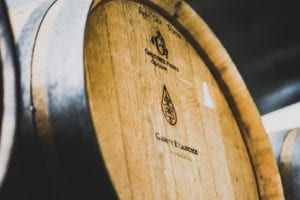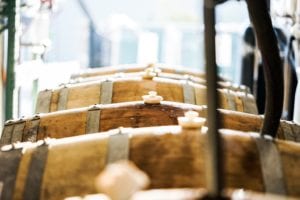The Art and Science of Barrel-Aged Beer
The Art and Science of Barrel-Aged Beer
Posted by Chris Leguizamon
3 years ago | June 22, 2021
Estimated Reading Time: 4 minutes, 34 seconds
BARRELS ARE INGREDIENTS TOO
Barrel-aged beer, or beer aged in wine and spirits barrels, often develops unique, complex flavor profiles that are not found in beer stored in stainless steel. Though you might not think it, we consider these barrels as ingredients. We respect what was aged in the barrel before it comes into our hands, and hope that some of those flavors—combined with the flavors of the wood itself—are imparted into the beer.
The unique characteristics that distinguish one barrel-aged beer from another are specific to the nuances of the barrel itself. And so, we design our beer to best suit the barrel we are planning to use. Many of our sours are aged in wine barrels, while our stouts are often aged in whiskey barrels. But one thing that all of our barrels have in common is that they are made of oak.
OAK: THE PURE WOOD OF CHOICE
 While many types of wooden barrels can be used for aging beer, oak is our go-to. Though it is watertight, it is also porous, and contains an array of flavors that can be extracted into beer—classically vanillin and tannins. These help to balance the beer and promote head retention.
While many types of wooden barrels can be used for aging beer, oak is our go-to. Though it is watertight, it is also porous, and contains an array of flavors that can be extracted into beer—classically vanillin and tannins. These help to balance the beer and promote head retention.
Because oak is permeable, micro-oxygenation occurs with all oak barrels and has a function in both “clean” and sour beers. Micro-oxygenation slowly oxidizes “clean” beer, and promotes long-term fermentation in our mixed culture projects (take Lief and Madeline, for example).
NUANCES BETWEEN BARRELS
We take many things into consideration when selecting barrels for use, such as:
american oak vs french oak
American oak grows with a wide grain, allowing the beer and barrel to interact more during the aging process. French oak, on the other hand, grows with a tight grain so the flavors imparted by the barrel are a bit more subtle.
charred barrel vs toasted barrel
Spirit barrels are charred inside, often imparting a smoky flavor, while wine barrels are toasted, adding smoother notes of vanilla and caramel.
spirit barrel vs wine barrel
Unlike spirit barrels, whose alcohol content kills off bacteria like Lactobacillus and Pediococcus and wild yeast like Brettanomyces, emptied wine barrels are often a breeding ground for them—which is essential in the creation of our sour beers.
BOURBON BARREL SPOTLIGHT: LOG CABIN
For this year’s Log Cabin release, we made three variants of the same imperial stout, each aged in a different type of bourbon barrel. Not all bourbons are the same, nor are all bourbon barrels the same. Aside from recipe differences, distilleries will use their own blend of oak as well as their own level of charring. This leads to distinct differences in the flavor profiles that we can derive from the used wood. As a result, the subtleties of each bourbon barrel used to age the Log Cabin variants translated into complex and pronounced differences between them.

AN INTELLECTUALLY CURIOUS ARTFORM
There are many nuances to barrel-aged beer, and each is considered when bringing you the best, most interesting beers. With an aim to deliver you ever-improving beers of the highest quality, we are constantly innovating our recipes, and testing new barrels and methods for aging. We get excited by tasting the unique contributions of a barrel to its beer, be it a sour or a stout. And we love to share the art and science behind our craft with you, almost as much as sharing the beer itself.
How do you barrel age beer?
Barrel aging beer is a process where beer is aged in wooden barrels to develop unique flavors and characteristics. Here’s a general overview of how to barrel age beer:
- Select a suitable barrel: Choose a barrel made of oak or another type of wood that has been previously used to age spirits or wine. Make sure the barrel is in good condition and properly cleaned.
- Prepare the barrel: If the barrel is new or hasn’t been used for a while, it needs to be hydrated to prevent leakage. Fill the barrel with water and let it soak for a period of time, usually a few days, to swell the wood and create a seal.
- Choose the beer: Select a beer style that can benefit from barrel aging. Beers with higher alcohol content, such as stouts, barleywines, or sour beers, are commonly aged in barrels.
- Transfer the beer: Transfer the beer into the barrel, making sure to minimize oxygen exposure. Fill the barrel as much as possible to reduce the headspace, which can lead to oxidation.
- Aging process: Store the barrel in a controlled environment, such as a cellar or temperature-controlled room. The aging time can vary depending on the desired flavors, but it can range from a few months to several years.
- Sampling and monitoring: Regularly sample the beer to monitor its progress and determine when it has reached the desired flavor profile. This allows you to decide when to remove the beer from the barrel.
- Bottling or blending: After aging, the beer can be either bottled directly from the barrel or blended with other beers to achieve a desired taste. Some brewers may also choose to add additional ingredients, such as fruit or spices, during this stage.
What are beer aging barrels?
Beer aging barrels are wooden containers, typically made of oak or other suitable woods, used for the process of aging beer. These barrels are specifically designed to impart unique flavors, aromas, and characteristics to the beer during the aging process. Beer aging barrels are often sourced from distilleries or wineries where they were previously used to age spirits or wine. The porous nature of the wood allows the beer to interact with the barrel, resulting in the development of complex flavors through the extraction of compounds from the wood.
Toasted vs charred barrel
In the context of barrel aging, the terms “toasted” and “charred” refer to different levels of heat treatment applied to the interior surface of the barrel. Here’s a comparison between toasted and charred barrels:
Toasted Barrel:
- Toasted barrels undergo a gentle heating process that lightly caramelizes the wood’s sugars.
- This process imparts subtle flavors and aromas to the beer, such as vanilla, coconut, or toffee.
- Toasted barrels are often preferred for aging lighter beers or those that benefit from a more delicate wood influence.
Charred Barrel:
- Charred barrels are exposed to higher heat, causing the interior surface to be charred or blackened.
- This charring process results in more pronounced flavors, including smoky, roasted, and even slightly burnt notes.
- Charred barrels are commonly used for aging robust beers like stouts, imperial porters, or barrel-aged barleywines.


